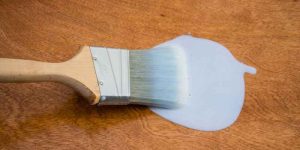Yes, you can apply water-based polyurethane over oil-based stain for a durable finish. This process is commonly done to protect and enhance the wood surface.
Water-based polyurethane dries faster and has less odor compared to oil-based polyurethane. It provides a clear finish while maintaining the richness of the wood stain underneath. Properly preparing the surface and following manufacturer’s instructions is crucial for successful application. The compatibility between the two products allows for a smooth and effective finish that will protect the wood for years to come.
Introduction To Water-based Polyurethane And Oil-based Stain
When considering refinishing wood surfaces, understanding the compatibility of water-based polyurethane and oil-based stain is crucial. Let’s delve into the characteristics of each to make an informed decision.
Key Characteristics Of Water-based Polyurethane
- Dries quickly
- Low odor
- Easy cleanup with water
- Non-yellowing formula
Why Choose Oil-based Stain?
- Deep penetration into wood
- Enhances natural wood grain
- Offers rich color tones
- Provides durability and long-lasting finish
Compatibility Between Water-based Polyurethane And Oil-based Stain
When considering applying water-based polyurethane over oil-based stain, understanding the compatibility between the two is crucial.
Chemical Interactions To Consider
- Water-based polyurethane can go over completely dried oil-based stain.
- Oil residue can hinder adhesion between the two finishes.
- Ensure proper cleaning and sanding for better compatibility.
Benefits Of Combining Both Finishes
- Enhances the durability of the wood surface.
- Water-based polyurethane provides a clear finish.
- Combining both finishes can offer a unique look.
Preparation Steps For Applying Water-based Polyurethane Over Oil-based Stain
When it comes to applying water-based polyurethane over oil-based stain, proper preparation is essential to ensure a successful and long-lasting finish. The process involves thorough cleaning, sanding, and application of the polyurethane. Here, we’ll focus on the crucial preparation steps for applying water-based polyurethane over oil-based stain.
Surface Cleaning Essentials
Before applying water-based polyurethane over oil-based stain, it’s crucial to ensure that the surface is clean and free of any dust, dirt, or debris. Use a tack cloth or a damp cloth to thoroughly clean the surface and remove any contaminants that may affect the adhesion of the polyurethane.
Sanding The Oil-based Stain
Sanding the oil-based stain is an important step to ensure proper adhesion of the water-based polyurethane. Use a fine-grit sandpaper (such as 220-grit) to lightly sand the entire surface, ensuring that the stain is smooth and free of any imperfections. This will create a suitable surface for the water-based polyurethane to adhere to.
Application Techniques For Best Results

When it comes to achieving the best results when applying water-based polyurethane over oil-based stain, the right application techniques are crucial. By following the correct methods, you can ensure a smooth, durable finish that enhances the beauty of the wood.
Choosing The Right Brush
Using the appropriate brush is essential for a successful application. Opt for a high-quality synthetic bristle brush to achieve even coverage and minimize the risk of brush marks.
Applying Thin Coats For Durability
To enhance the durability of the finish, apply thin coats of water-based polyurethane. Thin coats dry more evenly and reduce the likelihood of drips or bubbles, resulting in a smoother and more professional-looking finish.
Drying Time And Curing Process
When it comes to applying water-based polyurethane over oil-based stain, understanding the drying time and curing process is crucial for a successful finish. Let’s take a closer look at the expected drying times and factors that can affect the curing process.
Expected Drying Times
The drying time of water-based polyurethane over oil-based stain can vary depending on various factors. However, as a general guideline, you can expect the polyurethane to dry to the touch within a couple of hours. This initial drying phase allows for the application of subsequent coats.
While the surface may feel dry, it is important to note that the polyurethane may still be vulnerable to damage during this initial drying period. It is advisable to wait at least 24 hours before subjecting the coated surface to any heavy use or placing objects on it.
For optimal results, it is recommended to wait a minimum of 48 hours before applying additional coats of water-based polyurethane over oil-based stain. This extended drying time ensures that the previous layer has fully cured, allowing for better adhesion and a smoother finish.
Factors Affecting The Curing Process
The curing process of water-based polyurethane over oil-based stain can be influenced by several factors. These factors include:
- Temperature and Humidity: Higher temperatures and lower humidity levels generally accelerate the drying and curing process, while lower temperatures and higher humidity levels can prolong it. It is important to apply the polyurethane in a well-ventilated area with suitable temperature and humidity conditions.
- Thickness of Coats: Applying thicker coats of polyurethane can extend the drying and curing time. It is recommended to apply thin, even coats to promote faster drying and better adhesion.
- Air Circulation: Good air circulation helps facilitate the drying and curing process. Ensure that the area where the polyurethane is applied has proper ventilation and airflow.
- Type of Stain: Different oil-based stains may have varying drying times, which can subsequently affect the curing process of the water-based polyurethane. Always refer to the manufacturer’s guidelines for the specific stain you are using.
By considering these factors and allowing sufficient drying and curing time, you can achieve a durable and professional-looking finish when applying water-based polyurethane over oil-based stain.
Troubleshooting Common Issues
Water based polyurethane can be applied over oil based stain, but it requires proper preparation. Sanding the surface, cleaning it thoroughly, and using a bonding primer are important steps to ensure a successful application.
Tackiness And How To Address It
If you’re experiencing tackiness after applying water-based polyurethane over oil-based stain, don’t worry. This issue is common and can be easily addressed. The tackiness is usually caused by the water-based polyurethane not drying completely due to the oil-based stain preventing it from penetrating the wood. To fix this issue, you can use a sandpaper to lightly sand the surface and then apply a thin layer of oil-based polyurethane. Allow the oil-based polyurethane to dry completely before applying a water-based polyurethane layer.
Preventing Bubbles And Streaks
Bubbles and streaks are another common issue that can occur when applying water-based polyurethane over oil-based stain. To prevent this, ensure that the surface is completely clean and dry before applying the water-based polyurethane. Use a clean and dry brush or roller to apply the polyurethane in a thin and even layer. Avoid over-brushing or over-rolling as this can cause bubbles and streaks. If bubbles or streaks do occur, wait for the polyurethane to dry completely and then sand the surface lightly before applying another layer.
In conclusion, tackling common issues when applying water-based polyurethane over oil-based stain can be easily managed. By following these tips, you can achieve a smooth and beautiful finish on your woodworking project.
Maintenance And Care Tips
After applying water-based polyurethane over oil-based stain, it’s important to follow proper maintenance and care tips to ensure the longevity and beauty of the finished wood surface.
Routine Cleaning Advice
Regularly dust the surface with a soft, dry cloth to remove any debris or dirt. For deeper cleaning, use a damp cloth with a mild wood cleaner. Avoid harsh chemicals or abrasive cleaners as they can damage the finish.
Repairing Scratches And Wear
If scratches or wear appear on the surface, lightly sand the affected area with fine-grit sandpaper. Wipe away the dust and apply a thin coat of water-based polyurethane to the sanded area, blending it with the surrounding finish. Allow it to dry thoroughly before using the furniture.
Expert Opinions And Case Studies
Professional Insights On Durability
Experts in the field of woodworking and finishing have provided valuable insights into the durability of applying water-based polyurethane over oil-based stain. According to professionals, the key to success lies in proper surface preparation and application techniques.
Real-world Examples Of Successful Applications
Real-world case studies have demonstrated successful applications of water-based polyurethane over oil-based stain. Many DIY enthusiasts and professional woodworkers have achieved excellent results by following best practices and using high-quality products.

Frequently Asked Questions
Can You Put Polyurethane Water Based Over Oil Based Stain?
Yes, you can apply water-based polyurethane over oil-based stain. Just make sure to sand the stained surface lightly and clean it thoroughly before applying the water-based polyurethane. This will ensure proper adhesion and a smooth finish.
How Long To Wait Between Oil-based Stain And Water-based Polyurethane?
Wait 24-48 hours for oil-based stain to dry before applying water-based polyurethane. This allows proper drying and prevents compatibility issues.
Can You Put Water-based Sealer Over An Oil Stain?
Yes, you can apply water-based sealer over an oil stain for effective protection and a durable finish.
Does Water Based Polyurethane Hold Up As Well As Oil Based?
Water-based polyurethane holds up well, comparable to oil-based. Both offer durability and protection for surfaces.
Conclusion
Based on our research, it is possible to put water-based polyurethane over oil-based stain, but it requires proper preparation and testing. It is important to ensure that the oil-based stain is completely dry and cured before applying water-based polyurethane. We highly recommend testing a small area first to ensure compatibility and adhesion.
Overall, it is important to follow manufacturer’s instructions and take necessary precautions to achieve the desired results.


